Sponsored ads:
Stock trade use of Gap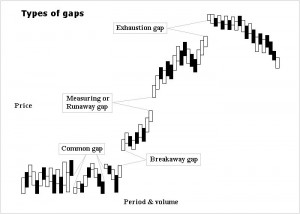
A gap is defined as an unfilled space or interval. On a technical analysis stock trade chart, a gap represents an area where no trading takes place. On the Japanese candlestick chart, a window is interpreted as a gap.
In an upward trend, a gap is produced when the highest price of one day is lower than the lowest price of the following day. Thus, in a downward trend, a gap occurs when the lowest price of any one day is higher than the highest price of the next day.
For example, the price of a share reaches a high of $30.00 on Wednesday, and opens at $31.20 on Thursday, falls down to $31.00 in the early hour, moves straight up again to $31.45, and no trading occurs in between $30.00 and $31.00 area. This no-trading zone appears on the chart as a gap.
Sponsored ads:
Gaps can play an important role when spotted before the beginning of a move.
Types of gaps
There are four different types of gaps, excluding the one that occurs as a result of a stock going ex-dividend. Since each type of gap has its own distinctive implication, it is very important to be able distinguish between such gaps.
-
- Breakway gap : It occurs when prices break away from an area of congestion. When the price is breaking away from a triangle (Ascending or Descending) with a gap then it can be implied that change in sentiment is strong and coming move will be powerful. One must keep an eye on the volume. If it is heavy after the gap is formed then there is a good chance that market does not return to fill the gap. When the price is breaking away on a low volume, there is a possibility that the gap will be filled before prices resume their trend.
- Common gap : It is also known as area gap, pattern gap or temporary gap. They tend to occur when trading (stock trade, bond trade, forex trade or commodity trade) is bound between support and resistance level on a short span of time and market price is moving sideways. One can also see them in price congestion area. Usually, the price moves back or goes up in order to fill the gaps in the coming days. If the gap is filled, then they offer little in the way of forecasting significance.
- Exhaustion gap signals end of a move. These gaps are associated with a rapid, straight-line advance or decline. A reversal day can easily help to differentiate between the Measuring gap and the Exhaustion gap. When it is formed at the top with heavy volume, there is significant chance that the market is exhausted and prevailing trend is at halt which is ordinarily followed by some other area pattern development. An Exhaustion gap should not be read as a major reversal.
- Measuring Gap : Also known as Runaway Gap, a Measuring gap is formed usually in the half way of a price move. It is not associated with the congestion area, it is more likely to occur approximately in the middle of rapid advance or decline. It can be used to measure roughly how much further ahead a move will go. Runaway gaps are not normally filled for a considerable period of time.
Caution
It is quite possible that confusion between measuring gap and exhaustion gap can cause an investor to position himself incorrectly and to miss significant gains during the last half of a major uptrend. Keeping an eye on the volume can help to find the clue between measuring and exhaustion gap. Normally, noticeable heavy volume accompanies the arrival of exhaustion gap.
Sponsored ads:
Trading gaps for profit
Some market speculators “Fade” the gap on the opening of a market. This means for example that if the S&P 500 closed the day before at 1150 (16:15 EST) and opens today at 1160 (09:30 EST), they will short the market expecting this “upgap” to close. A “downgap” would mean today opens at for example 1140, and the speculator buys the market at the open expecting the “downgap to close”. The probability of this happening on any given day is around 70%, depending on which market you look at. Once the probability of “gap-fill” on any given day or technical position is established, then the best setups for this trade can be identified. Some days have such a low probability of the gap-filling that speculators will trade in the direction of the gap.
Examples
Measuring gap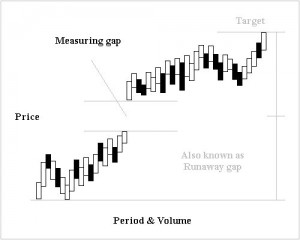 |
Exhaustion gap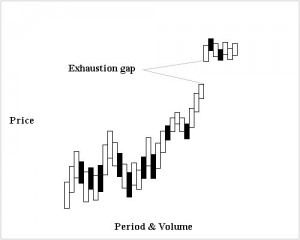 |
Common gaps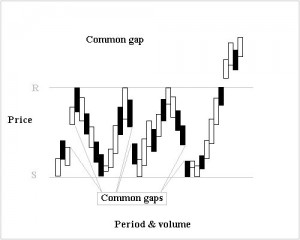 |
Breakaway gap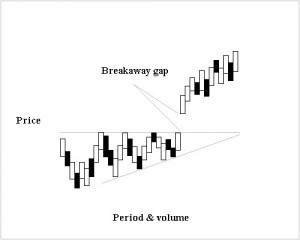 |
Continue to the next lesson
Sponsored ads:
